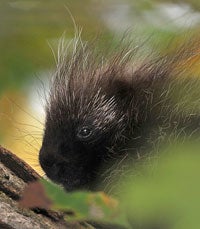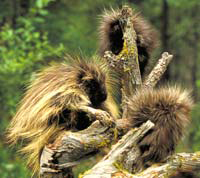
SCIENTIFIC NAME
Erethizon dorsatum
DESCRIPTION
Porcupines have large, chunky bodies and short legs. This results in their slow, waddling manner. With an average weight of 5.5 kg for males and 4.5 kg for females and a total length ranging from 68 to 100 cm, porcupines are Canada's second largest rodents next to beavers. Porcupine's quills are actually modified hairs. They are longest on the back and tail, reaching lengths of 12.5 cm. Quills on the face are much shorter, approximately 1.2 cm long. Despite their prickly appearance, porcupines have soft undercoats with long guard hairs covering the quills. Their undersides, legs, and muzzles have no quills.
RANGE
The porcupine occurs in North America in a wide range.
HABITAT
Porcupines occupy a variety of habitat types. They can be found in mature forests, dwarfed pine thickets, or alder bushes. Trees are an important component of porcupine habitat, as are the shrubs and herbaceous vegetation underneath. These provide food and protection from predators. Rock crevices, logging slash, caves, and culverts act as important winter den sites.
DIET
Porcupines are strict herbivores, but their diet changes with the seasons. In winter, they feed on the inner bark of trees such as fir, cedar, and hemlock. In spring, their favorite is maple bark as well as the catkins and leaves of willow, poplar, and alder. In summer, they eat the leaves of herbs and shrubs including clover, thorn apple, and currant, as well as water lily, and arrowhead. In fall, they switch to acorns and beechnuts. Porcupines also love salt. This often attracts them to salted roads during winter, resulting in many fatalities. They will even chew on wooden tool handles that have absorbed human perspiration.
BEHAVIOUR
undefinedPRIMARY ECOSYSTEM ROLES
Photo Gallery
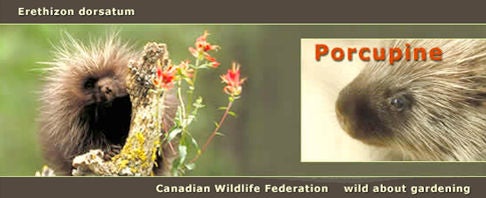
Erethizon dorsatum
Porcupine's quills are actually modified hairs. They are longest on the back and tail, reaching lengths of 12.5 cm. Quills on the face are much shorter, approximately 1.2 cm long. Though porcupines are not generally associated with water, these hollow quills provide buoyancy, thereby enabling them to swim.
|
Photo: US Department of Fish & Wildlife |
Porcupines occupy a variety of habitat types. They can be found in mature forests, dwarfed pine thickets, or alder bushes. Trees are an important component of porcupine habitat, as are the shrubs and herbaceous vegetation underneath. These provide food and protection from predators. Rock crevices, logging slash, caves, and culverts act as important winter den sites.
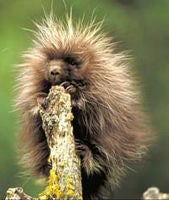
Porcupines are strict herbivores, but their diet changes with the seasons. In winter, they feed on the inner bark of trees such as fir, cedar, and hemlock. In spring, their favorite is maple bark as well as the catkins and leaves of willow, poplar, and alder. In summer, they eat the leaves of herbs and shrubs including clover, thorn apple, and currant, as well as water lily, and arrowhead. In fall, they switch to acorns and beechnuts. Porcupines also love salt. This often attracts them to salted roads during winter, resulting in many fatalities. They will even chew on wooden tool handles that have absorbed human perspiration.
If porcupines are causing problems for your trees, you can protect them by placing a 60 – 75 cm metal band around each tree at a height of about 1 m off the ground. This will prevent porcupines from being able to climb your trees. In winter, remember to take snow height into consideration. Don't leave the band up for extended periods of time as insects may accumulate under it.
Porcupines first breed between the ages of one and two years. Mating takes place from October to November and, following a gestation period of seven months, a single young offspring, called a porcupette, is born. A newborn porcupine weighs approximately 0.4 kg and is 30 cm in length. At birth, porcupettes have open eyes, teeth, and a covering of thick black hair. Newborns even have quills. Soft at first, they harden within hours of birth.
Young porcupines develop quickly and are able to move around soon after birth. At seven to ten days, the babies are weaned from their mothers and already eating vegetation. Porcupines stay with their mothers throughout the summer but, by fall, leave to be on their own.
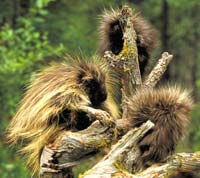
Predators include fishers, coyotes, bobcats, and mountain lions. These animals have learned that flipping a porcupine on its back exposes its unprotected underside and leaves it basically defenseless. However, that doesn't mean the predators walk away without serious quill injuries.
Porcupines are not aggressive. If they sense danger, they will try to reach shelter. If a predator prevents a porcupine from reaching safety, it will hump its back and tuck its head between its shoulders for protection. Then, with its back to the predator and quills erect, the porcupine will stomp its hind feet and threateningly beat its tail. This action may loosen some quills that may become embedded in its attacker.
Dogs by nature are curious animals and never seem to remember what a muzzle full of quills feels like. You can help protect your dog by making noise before letting it out. This will forewarn the porcupines of possible danger.
While considered pests by some, porcupines are also beneficial. One of their favourite foods is dwarf mistletoe, a parasitic seed plant of coniferous trees. Dwarf mistletoe causes reduced tree growth, lower wood quality, and sometimes tree mortality. Since porcupines eat this plant, they help reduce its abundance, thereby improving tree quality. Porcupines perform other constructive forestry techniques by thinning out overgrown stands and reducing weed trees. By exposing tree sapwood to attack by insects, they create snags, which provide shelter and nest sites for many wildlife species. In addition, excess food, that falls to the ground as a porcupine feeds, creates a food source for deer and other small mammals.
So, next time you notice a porcupine in your backyard take some time to watch its ways. You will discover an animal that is interesting, passive, and beneath that prickly exterior rather charming!
- 0

